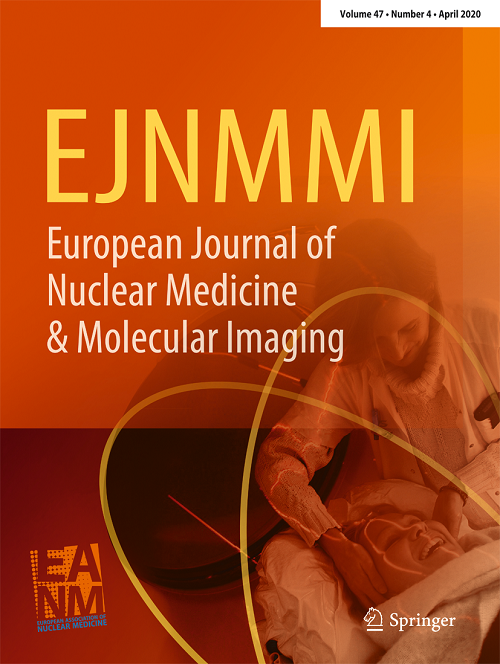AI lesion tracking in PET/CT imaging: a proposal for a Siamese-based CNN pipeline applied to PSMA PET/CT scans.
IF 7.6
1区 医学
Q1 RADIOLOGY, NUCLEAR MEDICINE & MEDICAL IMAGING
European Journal of Nuclear Medicine and Molecular Imaging
Pub Date : 2025-07-08
DOI:10.1007/s00259-025-07426-5
引用次数: 0
Abstract
PURPOSE Assessing tumor response to systemic therapies is one of the main applications of PET/CT. Routinely, only a small subset of index lesions out of multiple lesions is analyzed. However, this operator dependent selection may bias the results due to possible significant inter-metastatic heterogeneity of response to therapy. Automated, AI-based approaches for lesion tracking hold promise in enabling the analysis of many more lesions and thus providing a better assessment of tumor response. This work introduces a Siamese CNN approach for lesion tracking between PET/CT scans. METHODS Our approach is applied on the laborious task of tracking a high number of bone lesions in full-body baseline and follow-up [68Ga]Ga- or [18F]F-PSMA PET/CT scans after two cycles of [177Lu]Lu-PSMA therapy of metastatic castration resistant prostate cancer patients. Data preparation includes lesion segmentation and affine registration. Our algorithm extracts suitable lesion patches and forwards them into a Siamese CNN trained to classify the lesion patch pairs as corresponding or non-corresponding lesions. RESULTS Experiments have been performed with different input patch types and a Siamese network in 2D and 3D. The CNN model successfully learned to classify lesion assignments, reaching an accuracy of 83 % in its best configuration with an AUC = 0.91. For corresponding lesions the pipeline accomplished lesion tracking accuracy of even 89 %. CONCLUSION We proved that a CNN may facilitate the tracking of multiple lesions in PSMA PET/CT scans. Future clinical studies are necessary if this improves the prediction of the outcome of therapies.PET/CT成像中的AI病变跟踪:一种基于siese的CNN管道应用于PSMA PET/CT扫描的建议。
目的评估肿瘤对全身治疗的反应是PET/CT的主要应用之一。通常,在多个病变中,只有一小部分指数病变被分析。然而,由于对治疗的反应可能存在显著的转移间异质性,这种依赖于操作者的选择可能会使结果产生偏差。自动化的、基于人工智能的病变跟踪方法有望分析更多的病变,从而更好地评估肿瘤反应。这项工作引入了一种Siamese CNN方法,用于PET/CT扫描之间的病变跟踪。方法采用sour方法对转移性去势抵抗性前列腺癌患者进行[177Lu]Lu-PSMA治疗两周期后,在全身基线和随访[68Ga]Ga-或[18F]F-PSMA PET/CT扫描中追踪大量骨病变。数据准备包括病灶分割和仿射配准。我们的算法提取合适的病变斑块,并将其转发到经过训练的Siamese CNN中,将病变斑块对分类为对应或非对应病变。结果采用不同的输入贴片类型和二维和三维的暹罗网络进行了实验。CNN模型成功地学会了对病变分配进行分类,在最佳配置下达到83%的准确率,AUC = 0.91。对于相应的病变,该管道的病变跟踪准确率达到89%。结论我们证明了CNN可以在PSMA PET/CT扫描中方便地跟踪多个病变。如果这能改善治疗结果的预测,未来的临床研究是必要的。
本文章由计算机程序翻译,如有差异,请以英文原文为准。
求助全文
约1分钟内获得全文
求助全文
来源期刊
CiteScore
15.60
自引率
9.90%
发文量
392
审稿时长
3 months
期刊介绍:
The European Journal of Nuclear Medicine and Molecular Imaging serves as a platform for the exchange of clinical and scientific information within nuclear medicine and related professions. It welcomes international submissions from professionals involved in the functional, metabolic, and molecular investigation of diseases. The journal's coverage spans physics, dosimetry, radiation biology, radiochemistry, and pharmacy, providing high-quality peer review by experts in the field. Known for highly cited and downloaded articles, it ensures global visibility for research work and is part of the EJNMMI journal family.

 求助内容:
求助内容: 应助结果提醒方式:
应助结果提醒方式:


